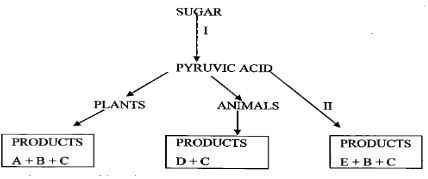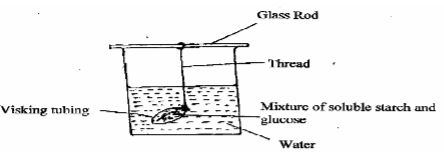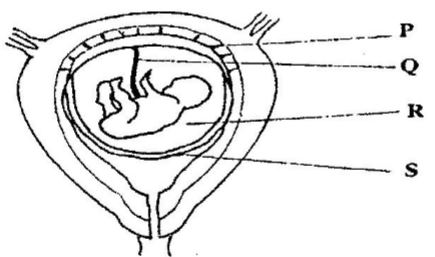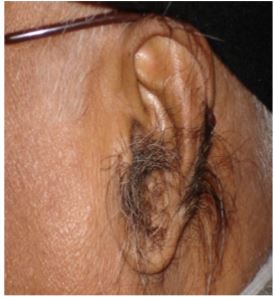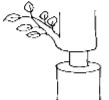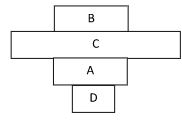Questions
- Some form one students wanted to collect the following animals for study in the laboratory. State the suitable apparatus they should use.
- Housefly (1 mk)
- Scorpion (1 mk)
- Ants (1 mk)
- A student was viewing a slide preparation of an onion cell under high power of a light microscope and observed that the features of the cell were blurred.
- Name the part of the microscope that the student would use to obtain sharper focus of the features. (1mk)
- State the function of mirror in a light microscope. (1mk)
-
- Guard cells are specialized epidermal cells. State two structural features which suit them to their function. (2mks)
- Apart from gaseous exchange, give one other function of stomata. (1mk)
- The diagram below is a specialized mammalian cell.
- Name the parts labeled B and D (2mks)
B..........................................................................................................................................................
D .......................................................................................................................................................... - State the function of the following
- Part labeled A (1mk)
- The portion marked C (1mk)
- Name the parts labeled B and D (2mks)
- Give two roles of the colon in human digestive system. (2marks)
- Distinguish between dentition and dental formula. (2marks)
- Name a carbohydrate that is abundant in the following;
- Ripe fruits. (1mark)
- Blood of vertebrates. (1mark)
- Apart from photosynthesis identify one other function of chloroplasts in plants. (1mark)
- Study the flow chart below and answer the questions that follow.
- Name the process taking place in step labeled I (1mk)
- Give two reasons why accumulation of substances D in the body leads to an increase in the heart beat. (2mks)
- Identify substance E (1mk)
- In an experiment to investigate a certain physiological process, a student had his experimental set up as shown below.
To ascertain the occurrence of the physiological process investigated he carried out food test on the water in the beaker. Both starch test and reducing sugar test at the beginning of the experiment were negative. After the set up was left undisturbed for 20 minutes, starch test was still negative but that of reducing sugar was positive.- State the physiological process which takes place in the human body illustrated by the set up above. (1mk)
- Name the part of the human body where the processes stated in (a) above takes place. (1mk)
- Study the diagram below and answer the following questions.
- State the function of the part labeled Q. (2marks)
- Identify a hormone produced by part labeled P. (1mark)
- Study the diagram below and answer the questions that follows
- What type of evolution is illustrated by the limbs (1mk)
- What does the origin of the limbs suggest about the ancestry of these animals (1mk)
- What are vestigial structures? (1mk)
- An investigation was carried out on a terrestrial ecosystem. The population sizes and species biomass were determined and recorded as shown in the table
Species Population size Species biomass A
B
C
D1 x 103
1 x 103
1 x 105
1 x 101 x 103
1 x 10-1
1 x 10
1 x 104- If these organisms had feeding relationships, construct a simple food chain involving all the organisms (1mk)
- Construct pyramid of numbers using the data provided above. (2mks)
- Study the photograph below showing a certain trait in man.
- Identify the trait exhibited in the photograph above. (1 mark)
- The trait you have identified in (d) (i) above is sex linked. In which chromosome is it contained. (1 mark)
- Name any other sex linked trait in man. (1 mark)
-
- State one significance of genetics counseling (1mk)
- Part of a strand of DNA molecules was found to have the following sequence
A-T-C-G-G-G-A-T-C-T.
What is the sequence?- Of the complementary strand? (1mk)
- On a m- RNA strand copied (1mk)
-
- State two significance of myelin sheath. (2mks)
- Name the cell that secretes the myelin sheath. (1mk)
- List the following in order in which they are involved in a simple reflex action. Motor neurone, effectors, stimulus, intermediate (relay) neurone, sensory neuron, impulse, receptor. (1mk)
- If the fish is removed from water it dies immediately. Explain why (2mks)
-
- What is seed dormancy (1Mk)
- Name a growth inhibitor in seed (1Mk)
- Differentiate between hypogeal and epigeal germination in seeds (2Mk)
- Name the causative agent of the following diseases in man (2Mks)
- Candidiasis :-
- Syphilis:-
- A group of form two students placed a fresh leaf in warm water. They observed that air bubbles formed on the surface of the leaf.
- What biological process were they investigating? (1mk)
- Name the structures from which the air bubbles were coming from. (1mk)
- Explain the distribution of the structures named in (b) above on the leaf surfaces of an aquatic plant. (2mks)
- Differentiate between hydrolysis and condensation. (2mks)
- Which sets of teeth would be used in chewing sugarcane for maximum extraction of sap? (2mks)
- In an experiment to determine the population of Tilapia fish in a school fish pond, students of Canada school decided to use capture-recapture method.
- Name three vital tools the students would need for the exercise. (3mks)
- State two factors that might affect the accuracy of their results. (2mks)
- What is the role of the following hormones in human reproduction?
- Follicle stimulating hormone in male (lmk)
- Luteinizing hormone during menstrual cycle. (lmk)
- Below is representation of an experiment that was carried out on a tree in Kayombe forest.
- Which two tissues are removed in a ring bark experiment? (2mks)
- Removal of the tissues above leads to some effects to the plant. Name these 2 effects. (2mks)
- Explain why Lamark’s theory of evolution is not accepted by modern scientist. (2mks)
- Name the branch of biology that deals with;
- Relationship between antelopes and gazelles in their environment. (lmk)
- Study of Ebola virus. (lmk)
- Explain what would happen if a given of living things lose their ability to reproduce. (lmk
- Study the diagram below and answer the questions that follow.
- Identify the bones labelled A and B. (2marks)
A ……………………………………………………………………..
B …………………………………………………………………….. - Name the joints found in the region labelled Y. (1mark)
- Identify the bones labelled A and B. (2marks)
-
- Explain the role of oxygen in Active transport (1mk)
- Name two processes that depend on Active transport in animals (2mks)
Marking Scheme
- Some form one students wanted to collect the following animals for study in the laboratory. State the suitable apparatus they should use.
- Housefly (1 mk)
- Sweep net;
- Scorpion (1 mk
- pair of forceps;
- Ants (1 mk)
- pooter
- Housefly (1 mk)
- A student was viewing a slide preparation of an onion cell under high power of a light microscope and observed that the features of the cell were blurred.
- Name the part of the microscope that the student would use to obtain sharper focus of the features. (1mk)
- Fine adjustment knob
- State the function of mirror in a light microscope. (1mk)
- Collects and reflects light to illuminate the specimen
- Name the part of the microscope that the student would use to obtain sharper focus of the features. (1mk)
-
- Guard cells are specialized epidermal cells. State two structural features which suit them to their function. (2mks)
- Inner thick wall and outer thin wall which result into unequal expansion causing opening and closing of stomata.
- Presence of many chloroplasts for photosynthesis
- Curved shape/bean shape
- Apart from gaseous exchange, give one other function of stomata. (1mk)
- Permits escape/loss of water vapour from the leaf transpiration
- Guard cells are specialized epidermal cells. State two structural features which suit them to their function. (2mks)
- The diagram below is a specialized mammalian cell.
- Name the parts labeled B and D (2mks)
- B – Nucleus
- D – tail/tail piece
- State the function of the following
- Part labeled A (1mk)
- Produces/contains lytic enzymes which dissolve, the vitelline membrane/wall of egg cell.
- The portion marked C (1mk)
- Contains numerous mitochondria which provides the necessary energy used to propel the sperm
- Part labeled A (1mk)
- Name the parts labeled B and D (2mks)
- Give two roles of the colon in human digestive system. (2marks)
- Have bacteria that synthesis vitamin K;
- Absorption of water;
- Distinguish between dentition and dental formula. (2marks)
- Dentition is description of the type, arrangement and specialization of the teeth while dental formula is the description of the number, type and position of the teeth in the jaws of the animal.
- Name a carbohydrate that is abundant in the following;
- Ripe fruits. (1mark)
- Fructose
- Blood of vertebrates. (1mark)
- Glucose
- Ripe fruits. (1mark)
- Apart from photosynthesis identify one other function of chloroplast in plants. (1mark)
- Storage of starch.
- Storage of chlorophyll pigment
- Study the flow chart below and answer the questions that follow.
- Name the process taking place in step labeled I (1mk)
- Glycolysis
- Give two reasons why accumulation of substances D in the body leads to an increase in the heart beat. (2mks)
- To provide the extra oxygen required to breakdown the lactic acid/D: increase supply of oxygen
- Speed up the transport of lactic acid /D from tissue, to the liver to be broken down
- Identify substance E (1mk)
- Water
- Name the process taking place in step labeled I (1mk)
- In an experiment to investigate a certain physiological process, a student had his experimental set up as shown below.
To ascertain the occurrence of the physiological process investigated he carried out food test on the water in the beaker. Both starch test and reducing sugar test at the beginning of the experiment were negative. After the set up was left undisturbed for 20 minutes, starch test was still negative but that of reducing sugar was positive.- State the physiological process which takes place in the human body illustrated by the set up above. (1mk)
- Ultra filtration/diffusion
- Name the part of the human body where the processes stated in (a) above takes place. (1mk)
- Kidney/glomerulus of the kidney tubule/nephrone
- State the physiological process which takes place in the human body illustrated by the set up above. (1mk)
- Study the diagram below and answer the following questions.
- State the function of the part labeled Q. (2marks)
- Umbilical VEIN carries blood rich in oxygen and nutrients from the placenta to the fetal circulation;
- Umbilical ARTERY carries blood rich in Carbon (IV) Oxide and (nitrogenous) metabolic wastes from the fetal circulation to the placenta;
- Identify a hormone produced by part labeled P. (1mark)
- Progesterone;
- State the function of the part labeled Q. (2marks)
- Study the diagram below and answer the questions that follows
- What type of evolution is illustrated by the limbs (1mk)
- Divergent evolution
- What does the origin of the limbs suggest about the ancestry of these animals (1mk)
- Ancestry origin of the lib suggests there were habitants of aquatic environment.
- What are vestigial structures?
- Highly reduced structure due to disuse
- What type of evolution is illustrated by the limbs (1mk)
- An investigation was carried out on a terrestrial ecosystem. The population sizes and species biomass were determined and recorded as shown in the table
- If these organisms had feeding relationships, construct a simple food chain involving all the organisms (1mk)
- D → A → C → B
- Construct pyramid of numbers using the data provided above. (2mks)
-
NOTE: A & B must be of the same size
C – Largest
D – smallest in size
-
- If these organisms had feeding relationships, construct a simple food chain involving all the organisms (1mk)
-
- Study the photograph below showing a certain trait in man
- Identify the trait exhibited in the photograph above. (1 mark)
- Hairy pinna
- The trait you have identified in (d) (i) above is sex linked. In which chromosome is it contained. (1 mark)
- Y -chromosome
- Name any other sex linked trait in man. (1 mark)
- Premature baldness
- Colour blindness
- Haemophilia
- Identify the trait exhibited in the photograph above. (1 mark)
- Study the photograph below showing a certain trait in man
-
- State one significance of genetics counseling (1mk)
- Provides information and advice to enable the victim to arrive at an informed decision on their genetic make up./disoders.
- Part of a strand of DNA molecules was found to have the following sequence
A-T-C-G-G-G-A-T-C-T.
What is the sequence?- Of the complementary strand? (1mk)
- T-A-G-C-C-C-T-A-G-A
- On a m- RNA strand copied (1mk)
- U-A-G-C-C-C-U-G-U
- Of the complementary strand? (1mk)
- State one significance of genetics counseling (1mk)
-
- State two significance of myelin sheath. (2mks)
- Increases the speed of impulse transmission
- Insulates the Axon
- Name the cell that secretes the myelin sheath. (1mk)
- Schwann cell
- List the following in order in which they are involved in a simple reflex action. Motor neurone, effectors, stimulus, intermediate (relay) neurone, sensory neuron, impulse, receptor. (1mk)
- Stimulus, receptor, impulse, sensory neurone, intermediate (relay) neurone, motor neurone, effectors
- State two significance of myelin sheath. (2mks)
- If the fish is removed from water it dies immediately. Explain why (2mks)
- Fish uses dissolved oxygen for gaseous exchange; gill filament epithelium dries up; gill filaments clamp together; surface area for gaseous exchange is reduced; oxygen lacks moist surface for dissolution causing death (due to suffocation)
-
- What is seed dormancy (1Mk)
- A period in which a mature seed cannot germinate even if provided with all the conditions necessary for germination when conditions are suitable
- Name a growth inhibitor in seed (1Mk)
- Abscisic acid (reject wrong spelling)
- Differentiate between hypogeal and epigeal germination in seeds (2Mk)
- Epigeal the cotyledon is brought above ground level (due to elongation of hypocotyl, )
- Hypogeal cotyledon remain below ground level (due to elongation of epicotyls)
- What is seed dormancy (1Mk)
- Name the causative agent of the following diseases in man (2Mks)
- Candidiasis :-
- Candida albicans
- Syphilis:-
- Treponema pallidum
- Candidiasis :-
- A group of form two students placed a fresh leaf in warm water. They observed that air bubbles formed on the surface of the leaf.
- What biological process were they investigating? (1mk)
- Gaseous exchange
- Name the structures from which the air bubbles were coming from. (1mk)
- Stomata
- Explain the distribution of the structures named in (b) above on the leaf surfaces of an aquatic plant. (2mks)
- Aquatic plants have stomata on the upper part of the leaves; to increase high rate of transpiration to encourage excess loss of excess water;
- What biological process were they investigating? (1mk)
- Differentiate between hydrolysis and condensation. (2mks) Hydrolysis — process by which complex molecules are broken to simpler molecules;While, condensation is the process by which simple molecules are combined to form complex compounds with formation of water.
-
- Which sets of teeth would be used in chewing sugarcane for maximum extraction of sap? (2mks)
- Premolars and molars
- Which sets of teeth would be used in chewing sugarcane for maximum extraction of sap? (2mks)
- In an experiment to determine the population of Tilapia fish in a school fish pond, students of Canada school decided to use capture-recapture method.
- Name three vital tools the students would need for the exercise. (3mks)
- Fish net Rej. Fishing net
- Water proof ink
- Data collection Notebook
- State two factors that might affect the accuracy of their results. (2mks) Can lead to underestimation/overestimation
- Birth/death may occur before second capture is done
- Method marking may interfere with organisms way of life
- Name three vital tools the students would need for the exercise. (3mks)
- What is the role of the following hormones in human reproduction?
- Follicle stimulating hormone in male (lmk) Synthesis and maturation of sperms
- Luteinizing hormone during menstrual cycle. (lmk) Stimulates the maturation of Graafian follicle
- Below is representation of an experiment that was carried out on a tree in Mt Kenya forest.
- Which two tissues are removed in a ring bark experiment? (2mks)
- Phloem Rej: Bark
- Epidermis
- Removal of the tissues above leads to some effects to the plant. Name these 2 effects. (2mks)
- Increased risk of infections
- Inability to translocate manufactured food downward the plant past the ring/swelling above the ring
- Which two tissues are removed in a ring bark experiment? (2mks)
- Explain why Lamark’s theory of evolution is not accepted by modern scientist. (2mks)
- The acquired characteristics are not inherited; since the traits are found in somatic cells only;
- Name the branch of biology that deals with;
- Relationship between antelopes and gazelles in their environment. (lmk)
- Ecology
- Study of Ebola virus. (lmk)
- Virology
- Explain what would happen if a given of living things lose their ability to reproduce. (lmk)
- They will become extinct with time
- Relationship between antelopes and gazelles in their environment. (lmk)
- Study the diagram below and answer the questions that follow.
- Identify the bones labelled A and B. (2marks)
- A- Ulna;
- B- Radius;
- Name the joints found in the region labelled Y. (1mark)
- Hinge-joint;
- Identify the bones labelled A and B. (2marks)
-
- Explain the role of oxygen in Active transport (1mk)
- Oxidize food to produce energy required in active transport
- rej to produce energy
- Name two processes that depend on Active transport in animals (2mks)
- Reabsorption of sugar and some salts by kidney;
- Absorption of digested food from alimentary canal;
- Excretion of waste products from body cell;
- Transmission of nerve impulse.
- Explain the role of oxygen in Active transport (1mk)
Join our whatsapp group for latest updates
Tap Here to Download for 50/-
Get on WhatsApp for 50/-
Download Biology Paper 1 Questions and Answers - Mathioya Mock Exams 2022.
Tap Here to Download for 50/-
Get on WhatsApp for 50/-
Why download?
- ✔ To read offline at any time.
- ✔ To Print at your convenience
- ✔ Share Easily with Friends / Students


